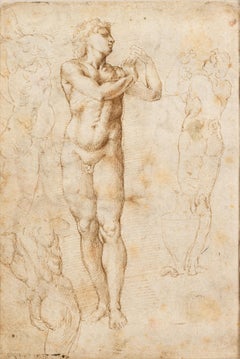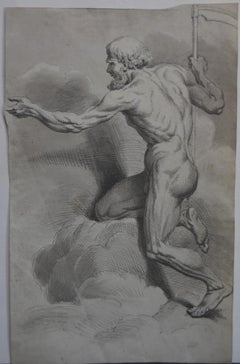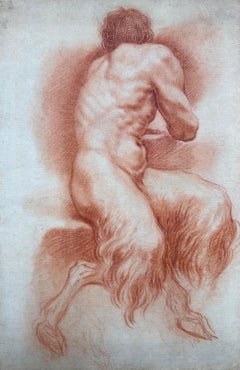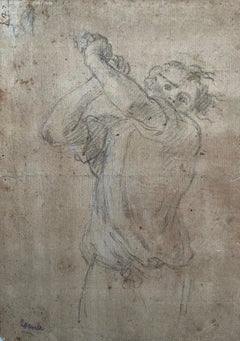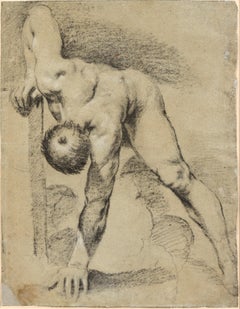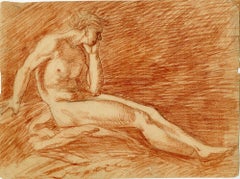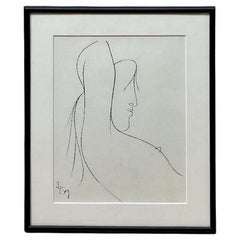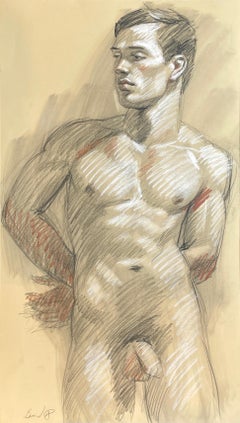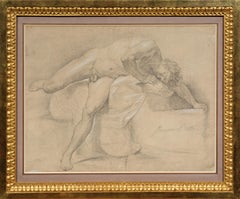18th Century and Earlier Nude Drawings and Watercolors
to
5
16
2
2
Overall Width
to
Overall Height
to
20
99
1,711
644
15
20
57
160
76
165
216
155
142
75
8
15
1
15
5
18
10
8
7
6
5
4
4
3
2
1
1
1
9
8
7
3
2
2
1
1
1
1
9
5
16
4
Period: 18th Century and Earlier
Studies of the Galli Statue and of an Ignudo
Located in Paris, Île-de-France
Florentine School, early 16th century
Studies of the Galli Statue and of an Ignudo
Pen and brown ink on laid paper
19.1 × 13 cm
Executed c. 1510–1520
Unsigned
This remarkable doub...
Category
Old Masters 18th Century and Earlier Nude Drawings and Watercolors
Materials
Ink
French Neo classical school, Allegory of Time, original drawing
Located in Paris, FR
Neo classical school, France, end of the 18th Century
Allegory of Time,
Pen and black ink on paper, gray ink wash
30.5 x 19 cm
irregularly shaped
In g...
Category
Old Masters 18th Century and Earlier Nude Drawings and Watercolors
Materials
India Ink
$566 Sale Price
30% Off
Study of a Seated Satyr, Seen from Behind
Located in Paris, Île-de-France
Domenico Maria Canuti (1625–1684)
Study of a Seated Satyr, Seen from Behind
Red chalk on laid paper with watermark
39 × 26 cm
Unsigned
Provenance:
Private Collection, France
Note...
Category
Old Masters 18th Century and Earlier Nude Drawings and Watercolors
Materials
Chalk
Roman School (circa 1590–1620) - Study Of An Executioner
Located in Paris, Île-de-France
Roman School (circa 1590–1620)
Study of a Male Executioner
Black chalk on laid paper,
275 x 199 mm
Unsigned
Formerly Giancarlo Sestieri Collection
This dynamic figure study, exe...
Category
Old Masters 18th Century and Earlier Nude Drawings and Watercolors
Materials
Chalk, Laid Paper
Leaning Nude Man (recto); Kneeling Man, Hands Tied Behind His Back (verso)
By Giovanni Francesco Barbieri (Il Guercino)
Located in Paris, Île-de-France
GIOVANNI FRANCESCO BARBIERI, known as GUERCINO
(1591-1666)
Leaning Nude Man (recto); Kneeling Man, Hands Tied Behind His Back (verso)
Black chalk heightened with white on light blu...
Category
Old Masters 18th Century and Earlier Nude Drawings and Watercolors
Materials
Chalk, Charcoal
Life study of a male nude in repose - European School, late 18th Century
Located in Middletown, NY
European School, late 18th century. Red chalk with primo pensiero in graphite on cream laid paper, 8 1/2 x 11 1/2 inches (215 x 293 mm). Scattered light handling wear and multiple s...
Category
Naturalistic 18th Century and Earlier Nude Drawings and Watercolors
Materials
Chalk, Laid Paper, Pencil, Graphite
Italian School, late 16th century - Head of a Man and Écorché Studies of Arms
Located in Paris, Île-de-France
Italian School, late 16th century
Head of a Man and Écorché Studies of Arms
Red chalk on laid paper,
21 x 11 cm
Provenance:
Collection of Michael Jaffé CBE (1923–1997), English art historian and Director of the Fitzwilliam Museum, Cambridge
Private collection, France
This drawing, attributed to the Italian School of the late 16th century, demonstrates the influence of Michelangelo’s approach to anatomy and expression. The sheet combines two distinct studies: an anatomical rendering of arms in the écorché technique, focusing on the musculature and skeletal details, and a head of a man, drawn with careful attention to light and shadow. The use of red chalk lends the work warmth and immediacy, qualities often associated with Renaissance studies of the human form.
The écorché studies reflect the Renaissance fascination with anatomy as both an artistic and scientific pursuit. The detailed depiction of the musculature suggests the artist’s interest in understanding the mechanics of the body, a practice heavily influenced by Michelangelo’s drawings...
Category
Old Masters 18th Century and Earlier Nude Drawings and Watercolors
Materials
Chalk
Study of Feet and a Figure Sketch
Located in Paris, Île-de-France
Attributed to Jacob JORDAENS (Antwerp 1593–1678)
Study of Feet and a Figure Sketch
Red and black chalk on laid paper
25.9 × 18.4 cm (10¼ × 7¼ in.)
Unsigned
Minor losses, folds, an...
Category
Old Masters 18th Century and Earlier Nude Drawings and Watercolors
Materials
Chalk
Sleeping Boy - Drawing by Giovanni Fontana - 16th Century
Located in Roma, IT
Sleeping Boy is an original modern artwork realized in the 16th century by Giovanni Fontana.
Ivory colored sheet attached on an ivory colored cardboard (...
Category
Old Masters 18th Century and Earlier Nude Drawings and Watercolors
Materials
Paper, Pencil
$3,591 Sale Price
20% Off
Old Master French Sanguine Drawing of Hercules
Located in Pasadena, CA
Old Master, French School red chalk drawing on paper is not signed .
Done in Sanguine on paper the nude appear like Hercule . The feel and look of the works while academic studies a...
Category
Baroque 18th Century and Earlier Nude Drawings and Watercolors
Materials
Archival Paper
Academy Study of a Seated Male Figure Seen from the Back
By Charles Joseph Natoire
Located in Paris, Île-de-France
Attributed to Charles-Joseph NATOIRE (Nîmes 1700 – 1777 Gandolfo)
Academy Study of a Seated Male Figure Seen from the Back
(Youthful study executed around the 1720s–1730s, likely du...
Category
Old Masters 18th Century and Earlier Nude Drawings and Watercolors
Materials
Chalk
Louis-Félix de La Rue (1730-1777) A Mythological scene, drawing
Located in Paris, FR
Louis-Félix de La Rue (1730-1777)
A Mythological scene
Pen and black ink on paper
Bears an old inscription with the name of the artist on the lower left bo...
Category
Old Masters 18th Century and Earlier Nude Drawings and Watercolors
Materials
Ink
$1,379 Sale Price
20% Off
Louis-Félix de La Rue (1730-1777) Putti playing around a sculpture, drawing
Located in Paris, FR
Louis-Félix de La Rue (1730-1777)
Putti playing around a sculpture, a mythological scene
Pen and brown ink on paper
15.4 x 31 cm
In good condition
The ancient mount has has a smal...
Category
Old Masters 18th Century and Earlier Nude Drawings and Watercolors
Materials
Ink
Three drawings by François Boucher in a mounting by Jean-Baptiste Glomy
Located in PARIS, FR
We would like to thank Juliette Parmentier-Courreau of the Custodia Foundation for her welcome and support during the consultation of Glomy’s Journal des Ouvrages.
This spectacularly large "feuille de desseins ajustés" commissioned by François Boucher from Jean-Baptiste Glomy is emblematic of the painter's art and mastery of rocaille. It is also fully representative of the taste of this period in the field of decorative arts. The largest of these three drawings, placed at the bottom of the composition, is particularly interesting: dating from around 1756, it constitutes a modello (apparently unpublished) for the frontispiece of the "Catalogue des tableaux de Monsieur de Julienne"), preserved in the Morgan Library in New York.
1. François Boucher, the master of French rocaille
The extraordinary career of Francois Boucher was unmatched by his contemporaries in versatility, consistency and output. For many, particularly the writers and collectors who led the revival of interest in the French rococo during the last century, his sensuous beauties and plump cupids represent the French eighteenth century at its most typical. His facility with the brush, even when betraying the occasional superficiality of his art, enabled him to master every aspect of painting – history and mythology, portraiture, landscape, ordinary life and, as part of larger compositions, even still life. He had been trained as an engraver, and the skills of a draftsman, which he imbued in the studio of Jean-Francois Cars (1661 – 1738), stood him in good stead throughout his career; his delightful drawings are one of the most sought-after aspects of his oeuvre.
As a student of Francois Lemoyne (1688 - 1737), he mastered the art of composition. The four years he spent in Italy, from 1727-1731, educated him in the works of the masters, classics and history, that his modest upbringing had denied him.
On his return to Paris in 1734, he gained full membership of the Royal Academy of Painting and Sculpture with his splendid Rinaldo and Armida (Paris, Musée du Louvre). Although, throughout his career, he occasionally painted subjects taken from the Bible, and would always have considered himself first as a history painter, his own repertoire of heroines, seductresses, flirtatious peasant girls and erotic beauties was better suited to a lighter, more decorative subject matter. His mastery of technique and composition enabled him to move from large scale tapestry...
Category
Old Masters 18th Century and Earlier Nude Drawings and Watercolors
Materials
Chalk, Ink
Study after Michelangelo’s “The Last Judgment”
By Michelangelo Buonarroti
Located in New York, NY
Italian School, 16th Century
Provenance:
Private Collection, New York
This intriguing drawing is a study by an anonymous 16th-century Italian artist after a vignette in Michelangelo’s fresco of The Last Judgement in the Sistine Chapel. The altar wall of the Sistine Chapel was already richly decorated when Pope Clement VII commissioned Michelangelo to paint his Last Judgment...
Category
Old Masters 18th Century and Earlier Nude Drawings and Watercolors
Materials
Paper, Gouache
Study of a Fate at mid-body, a red chalk attributed to Giovanni da San Giovanni
Located in PARIS, FR
This spectacular red chalk drawing depicts an elderly woman, her eyes bulging, her hand stretched out towards the sky. This disturbing character, who seems close to dementia, and the elongation of her arm with its Mannerist overtones, plunge us into the Florentine artistic milieu of the first half of the 17th century. The proximity of this drawing to some characters in the fresco in the Pitti Palace representing The Muses, Poets and Philosophers chased from Parnassus, the last masterpiece of Giovanni da San Giovanni, leads us to propose an attribution to this artist and a dating of around 1635-1636.
1. Giovanni da San Giovanni, the painter of contradiction
We take here the title of the monography dedicated to the artist by Anna Banti in 1977, which remains the reference book for this artist. The son of a notary, Giovanni Mannozzi, known as Giovanni da San Giovanni, abandoned his studies to go to Florence at the age of sixteen, where he entered the studio of Matteo Rosselli (1578 - 1650) around 1609 and enrolled in the Academy of Drawing Arts in 1612. Around 1615 he produced his first known works, mainly frescoes for the city's tabernacles. He became famous in Florence for his originality, combining an obsessive application to the study of drawing and the reading of poetry and history with a disheveled appearance. Between 1619 and 1620 he decorated the facade of the Antella Palace in Piazza Santa Croce, a decoration that still partly survives today.
The death of Cosimo II in 1621 put an end to the Florentine building activity and Giovanni da San Giovanni left for Rome to find other sponsors with the painter Francesco Furini...
Category
Old Masters 18th Century and Earlier Nude Drawings and Watercolors
Materials
Chalk
Untitled-055 Pastel Figure by Hans Burkhardt
Located in Hudson, NY
Hans Burkhardt frequently used live models for his figural pastels, which he maintained an interest in throughout his long career.
Untitled (1972)
Pastel on paper
25" x 20"
Signed a...
Category
American Modern 18th Century and Earlier Nude Drawings and Watercolors
Materials
Paper, Pastel
Study in the Antique Style, a neoclassical drawing by Augustin Pajou
Located in PARIS, FR
In this lively and fresh drawing, probably taken from one of the artist's notebooks, Pajou presents us with a composition freely inspired by antiquity, as a souvenir of a visit to th...
Category
Old Masters 18th Century and Earlier Nude Drawings and Watercolors
Materials
Ink
Francesco Furini Sanguine Drawing before 1642
Located in Florence, IT
Preparatory Drawing (sanguine on paper, 42 x 28 cm) by Francesco Furini for the making of the Saint Sebastian, ordered by the prince Lorenzo de' Medic...
Category
Baroque 18th Century and Earlier Nude Drawings and Watercolors
Materials
Paper, Color Pencil
Sketch front back neoclassicism Milanese caryatids of the 18th century
Located in Florence, IT
Double-sided sketch for the "Sala delle Cariatidi" of the Royal Palace in Milan.
The vibrant and intense brown ink sketch of these two female figures, executed by the Parma plastici...
Category
Other Art Style 18th Century and Earlier Nude Drawings and Watercolors
Materials
Paper, Ink
Related Items
Nude Woman Profile Drawing by Radoczy
Located in Pasadena, CA
Reclining Female figure, original signed line drawing, in pencil and ink by Albert Radoczy.
Albert Radoczy was a master at exploring the female form. Throughout his career, his draw...
Category
Modern 18th Century and Earlier Nude Drawings and Watercolors
Materials
Ink, Pencil
$304 Sale Price
20% Off
H 14.38 in W 11.88 in D 0.88 in
MB 023 (Figurative Life Drawing of Handsome Male Nude by Mark Beard)
By Mark Beard
Located in Hudson, NY
Academic life drawing of male nude with charcoal and graphite by Mark Beard, "MB 023"
graphite, Conte crayon and charcoal on Arches paper
30.5 x 17.5 inches unframed
Signed, lower le...
Category
Contemporary 18th Century and Earlier Nude Drawings and Watercolors
Materials
Conté, Charcoal, Archival Paper, Graphite
$1,650
H 30.5 in W 17.5 in
Disegno figurativo neoclassico fiorentino studio di nudo in cornice intagliata
Located in Florence, IT
Questo disegno, matita su carta 14 x 10 cm, è uno squisito esempio di "Accademia", ovvero studio dal vero da modello nudo che era una delle attività tipiche nelle accademie, soprattu...
Category
Other Art Style 18th Century and Earlier Nude Drawings and Watercolors
Materials
Paper, Pencil
MB 005 (Modern, Traditional Style Figurative Life Drawing of Muscular Male Nude)
By Mark Beard
Located in Hudson, NY
Figurative nude drawing on Arches paper
graphite, conte crayon and charcoal on Arches paper
22 x 15 inches unframed
Contemporary figurative life study drawing of a reclining male nu...
Category
Modern 18th Century and Earlier Nude Drawings and Watercolors
Materials
Conté, Graphite
Study of a Man's Shoulder
By Glyn Philpot
Located in London, GB
Black chalk heightened with white chalk on blue paper, 19cm x 15cm, (32cm x 27cm framed).
First exhibiting at the Royal Academy in 1904, Philpot was elected as an Academician in 1923. Like many artists of his generation, he enjoyed a comfortable income from portraiture, which enabled him to paint less commercially successful and perhaps more personal subjects. His interest in the male nude and portraits of...
Category
Art Deco 18th Century and Earlier Nude Drawings and Watercolors
Materials
Charcoal, Chalk, Paper
Figure Drawing by Mark Beard (Muscular Male Nude Charcoal Life Drawing)
By Mark Beard
Located in Hudson, NY
Academic life drawing of male nude with charcoal and graphite by Mark Beard
graphite, Conte crayon and charcoal on Arches paper
30 x 19.5 inches unframed
Signed, lower left
Strong f...
Category
Contemporary 18th Century and Earlier Nude Drawings and Watercolors
Materials
Charcoal, Archival Paper, Graphite, Conté
$1,700
H 30 in W 19.5 in
French School, Academic Study (Male Nude)
Located in London, GB
Charcoal on paper, 60cm x 42cm, (74cm x 60cm framed). The picture is framed behind museum quality non-reflective UV glass.
Drawings and paintings of the nude were central to academ...
Category
Old Masters 18th Century and Earlier Nude Drawings and Watercolors
Materials
Paper, Carbon Pencil
Little witches 4
Located in Genève, GE
Erotic scene
Work on paper
Wooden frame with glass pane
49.5 x 41.5 x 1.3 cm
Category
Modern 18th Century and Earlier Nude Drawings and Watercolors
Materials
Ink
BLUE SUN original art Paula Craioveanu Nude inspired by Matisse
Located in Forest Hills, NY
“Blue Sun” Tempera pencil charcoal on blue paper
Shipped rolled in a tube 25x3x3in. Drawing was originally in mat.
This piece, Blue Sun, is a striking and evocative work that captur...
Category
Contemporary 18th Century and Earlier Nude Drawings and Watercolors
Materials
Ink, Tempera, Archival Paper
$500
H 27.5 in W 19.5 in
MB 824 (Double-Sided Figure Drawing of Handsome Nude Men by Mark Beard)
By Mark Beard
Located in Hudson, NY
Figurative, academic style life drawing of male nude with charcoal and graphite by Mark Beard, "MB 824"
graphite, Conte crayon and charcoal on Arches paper
30.5 x 21 inches unframed
...
Category
Contemporary 18th Century and Earlier Nude Drawings and Watercolors
Materials
Conté, Charcoal, Archival Paper, Graphite
MB 702 (Contemporary Life Drawing of Male Nude by Mark Beard)
By Mark Beard
Located in Hudson, NY
MB 702 (Contemporary Life Drawing of Male Nude by Mark Beard)
graphite, Conte crayon and charcoal on Arches paper
30 x 19 inches unframed
Con...
Category
Contemporary 18th Century and Earlier Nude Drawings and Watercolors
Materials
Conté, Charcoal, Archival Paper, Graphite
MB 001 (Modern, Academic Style Figurative Life Drawing of Muscular Male Nude )
By Mark Beard
Located in Hudson, NY
Figurative male nude drawing on Arches paper by Mark Beard
graphite, conte crayon and charcoal on Arches paper
22 x 15 inches unframed
Contemporary figurative life study drawing of ...
Category
Modern 18th Century and Earlier Nude Drawings and Watercolors
Materials
Conté, Graphite
Previously Available Items
A spectacular Study of a sleeping nude Man by Pompeo Batoni (1708 - 1787)
Located in PARIS, FR
The attribution to Pompeo Batoni has been confirmed by Professor Francesco Petrucci based upon a photography of the artwork.
This impressive study of a nude man belongs to a series ...
Category
Old Masters 18th Century and Earlier Nude Drawings and Watercolors
Materials
Paper, Chalk
Study after Farnese Hercules
Located in Paris, Île-de-France
Study after the Farnese Hercules
Giovan Ambrogio Figino (1548-1608)
Black chalk on blue-prepared paper 33 x 23 cm
Provenance: Tajan, Drouot Paris, 23 November 2001, lot 11; Private ...
Category
Renaissance 18th Century and Earlier Nude Drawings and Watercolors
Materials
Chalk
Satyr conversing with a Nymph, a drawing attributed to Claude Mellan
By Claude Mellan
Located in PARIS, FR
Provenance: Collection from central Italy in the 17th century (Stamp - probably L. 3900 - on the front, top left)
Sir Joshua Reynolds (1723 - 1792), stamped lower right (L. 2364)
This mythological drawing from the collection of Sir Joshua Reynolds has long been attributed to Pietro da Cortona, as evidenced by the inscriptions at the bottom and on the reverse. While the Italian collection stamp (which predates Reynolds') suggests that this drawing was executed in Italy in the 17th century, it seems to us to be much closer to the drawings produced in Rome in the entourage of Simon Vouet. Its numerous hatchings, evocative of burin work, and its luminous composition lead us to suggest an attribution to Claude Mellan, who befriended Vouet on his arrival in Rome in 1624.
1. The stay in Vouet's studio, an important phase in Claude Mellan's training
Claude Mellan was born on May 23, 1598 in Abbeville, where his father worked as a boilermaker and copper planer. In 1615, at the age of 17, he was apprenticed to Jean V Leclerc, a mediocre Parisian engraver. Nine years later, in 1624, he left for Rome with the support of Provencal scholar Nicolas-Claude Fabri de Peiresc.
Having established contact with the engraver Francesco Villamena (who died two months after his arrival in Rome), Mellan quickly made friends with the painter Simon Vouet, then at the height of his reputation in Rome thanks to his recent appointment as director of the Accademia de San Luca. Simon Vouet and Gian Lorenzo Bernini (known as Le Bernin...
Category
Old Masters 18th Century and Earlier Nude Drawings and Watercolors
Materials
Chalk
H 12.25 in W 16.75 in
Bartolomeo Passarotti (1529-1592) - Study Of Two Legs
Located in Paris, Île-de-France
BARTOLOMEO PASSAROTTI
(Bologna 1529 - 1592)
Study of two legs
Pen and brown ink, over black chalk, on paper
34,5 x 21,5 cm
Bears lower left the collector mark of Maurice Marignane ...
Category
Renaissance 18th Century and Earlier Nude Drawings and Watercolors
Materials
Ink
H 13.39 in W 8.27 in
Untitled (Standing Female Nude)
Located in Fairlawn, OH
Untitled (Standing Female Nude)
Graphite on paper, c. 1930
Signed bottom right: Lorski (see photo)
Sheet size: 9 5/16 x 5 13/16 inches
From a sketchbook created while the artist was working in Paris
Condition: Good
Thin spots verso from previous mounting
Soft vertical fold running across image
Barely visible on recto
Provenance: Estate of the Artist
Dawson's Auctioneers and Appraisers, 2001
Amity Art Foundation
Boris Lovet-Lorski
Lithuanian/Russian/American
1894-1973
Sculptor, painter, and printmaker, Boris Lovet-Lorski was born in Lithuania in 1894. His mother died when he was age three. His father was affluent and owned real estate. Boris grew up in a privileged environment. He studied architecture and then fine arts at the Imperial Academy of Art in Petrograd, Russia (now Saint Petersburg). Following the revolution in 1917 and its aftermath, Boris immigrated to Boston to live with his brother. In the 1920’s, his stylized, Art Deco inspired sculptures, lithographs, and paintings proved to be popular among the American elite. He exhibited frequently, holding his first solo exhibition in Boston, 1920. In the following years, Boris exhibited in New York at Marie Sterner Gallery, Jacques Seligmann Galleries and Wildenstein and Company. He lived in Paris from 1926 to 1932 where he befriended Joseph Hecht, and was exposed to the works of Pablo Picasso, Ossip Zadkine, Contantin Brancusi and Aristide Maillol. In 1932 he returned to America where he became a citizen later in the decade.
Lovet-Lorski exhibited in the United States, South America, Europe and Asia. He was a member of the Society of Independent Artists (New York), the National Academy of Design (New York), and the Lotos Club (New York), as well as several Parisian salons. His work is in the permanent collections of numerous museums including the Musée Luxembourg, Bibliotèque Nationale, and the Petit Palais in France, the British Museum in London, the Metropolitan Museum in New York, the National Gallery in Washington, the Los Angeles County Museum of Art. (A more extensive list of his works in museums follows) He is considered one of the most successful and recognized sculptors of his generation. His creative influence can be seen in many of his contemporary artists.
He died in Los Angeles in 1973.
Regarding his iconic Art Deco sculptures of Cretan Dancers:
“The stylizing of the Cretan allegories, used in figures of animals such as horses and bulls, symbolizes the ancient power of the South. These figures reveal a spiritual sensuality as he strives to attain a symbol of the earth and universe endowed with musical values. If man is the center of his idea of life and nature, it is because of the laws that govern the movement of stars and history. The link binding his figures together has, in a sense, a Pythagorean harmony.”
Salvatore Quasimodo, Milan, 1967, quoted from Bush, Boris Lover-Lorski: The Language of Time, page 12.
Lovet-Lorski created sculptures of the following major figures
I.J. Paderewski, Prime Minister of Poland
Arturo Toscanini, Italian Conductor
Lilian Gish, Actress
President Franklin D. Roosevelt
Mrs. M. C. Niarchos, wife of Stavros Niarchos
President Abraham Lincoln
James Forrestal, Secretary of the Navy, First Secretary of Defense
Pope Pius XII
Dr. Albert Einstein, theoretical physicist
President Dwight D. Eisenhower
Albert Schweitzer, theologian, organist, writer, humanitarian, philosopher, and physician
General Charles De Gaulle, President of the Fourth and Fifth Republic, France
John Foster Dulles, Secretary of State, 1953-1959
President John F. Kennedy
Works by Lover Lorski are in the following public collections:
Albright-Knox Art Gallery, Buffalo
Art Institute of Chicago
Bibliotheque Nationale, Paris
Brandeis University, Waltham, MA
British Museum, London
Boston University
Brooklyn Museum
California Palace of the Legion of Honor, Sam Francisco...
Category
Art Deco 18th Century and Earlier Nude Drawings and Watercolors
Materials
Graphite
The Captive, Study of a Naked Man, Red Chalk Study, Carracci Gallery
By Annibale Carracci
Located in London, GB
Red chalk on paper
Image size: 11 x 5 1/2 inches (28 x 14 cm)
Mounted
This 18th century drawing is after the work of the 16th Century Italian artist Annibale Carraci. This figure, along with many more, were painted by Carraci in the Palazzo Farnese in a space now known as the Carracci gallery. The Carracci gallery is considered as one of the most important Renaissance commissions in Rome. This figure, along with five other companions, were known as 'The Captives'. They were designed by the artist to appear trapped in the architectural spaces in the walls and sat around the fresco that featured Perseus and Andromeda.
Annibale Carracci
Annibale Carracci (1560–1609) was the most admired painter of his time and the vital force in the creation of Baroque style. Together with his cousin Ludovico (1555–1619) and his older brother Agostino (1557–1602)—each an outstanding artist—Annibale set out to transform Italian painting. The Carracci rejected the artificiality of Mannerist painting, championing a return to nature coupled with the study of the great northern Italian painters of the Renaissance, especially Correggio, Titian, and Veronese.During the 1580s, the Carracci were painting the most radical and innovative pictures in Europe. Annibale not only drew from nature, he created a new, broken brushwork to capture movement and the effects of light on form. His Two Children Teasing a Cat marks a new chapter in the history of genre painting.
The revolutionary potential of this new kind of painting would be taken up over a decade later by Caravaggio, who must have seen the Carraccis’ work while traveling from Milan to Rome in 1592.The Carracci saw themselves as heir to a great artistic tradition, and they consciously situated themselves within the history of northern Italian painting. Annibale and Agostino visited Parma and Venice to study the work of Correggio, Titian, Tintoretto, and Veronese. Their altarpieces and secular fresco cycles in Bologna reasserted a northern Italian emphasis on color, light, and the study of nature, but with a new focus on emotive communication. Their success led to Annibale being invited to Rome to work for the powerful Farnese family (1595). Ludovico remained in Bologna to direct the academy they founded. Through the next generation of painters—Francesco Albani, Domenichino, Guido Reni, Giovanni Lanfranco, and Guercino—Bolognese painting became the dominant force in seventeenth-century art.
In Rome, Annibale’s painting was transformed through his first-hand encounter with classical antiquity and the art of Michelangelo and Raphael. Individual scenes of ancient mythology are surrounded by an elaborate illusionistic framework with feigned statues, in front of which sit muscular nude figures seemingly lit from the actual windows (Galleria Farnese ceiling). The corners are opened to painted views of the sky. When unveiled in 1600, the ceiling was instantly acclaimed as the equal of any work in the past. In combining northern Italian naturalism with the idealism of Roman painting, Annibale created the basis of Baroque art. His only challenger in Rome was Caravaggio, whose relation with the past was combative rather than assimilative. Moreover, Caravaggio’s art...
Category
Renaissance 18th Century and Earlier Nude Drawings and Watercolors
Materials
Paper, Chalk
Candelstick project, a drawing attributed to Giulio Romano (circa 1499 - 1546)
Located in PARIS, FR
This drawing is very close to the other silverware designs created by Giulio Romano for the Gonzaga court in Mantua, where he settled from 1524 onwards. An exhibition organized a yea...
Category
Old Masters 18th Century and Earlier Nude Drawings and Watercolors
Materials
Ink, Laid Paper
18th Century Italian Old Master Drawing Nude Figure Sketches Male & Female
Located in Cirencester, Gloucestershire
Figurative Sketches
Italian School, mid 18th century
circle of Pompeo Batoni (1707-1787)
charcoal and pencil, heightened with white chalk, unframed...
Category
Old Masters 18th Century and Earlier Nude Drawings and Watercolors
Materials
Chalk, Charcoal, Pencil
French School 18th century, The Judgement of Paris, original drawing
Located in Paris, FR
French School 18th century,
The Judgement of Paris,
Pen and back ink and black ink wash on paper
14.5 x 17 cm
Framed : 28 x 31 cm
The particularly fine execution of this 18th century drawing is reminiscent of the style of the great draughtsmen of the period, but at this stage there is no sure way of attributing it.
The theme of the work is obviously well known, the Judgement of Paris was particularly popular, and we remember its treatment by Antoine Watteau, but it crosses the whole history of art.
The Judgement of Paris is a story from Greek mythology, which was one of the events that led up to the Trojan War and in later versions of the story to the foundation of Rome :
Eris, the goddess of discord, was not invited to the wedding of Peleus and Thetis. In revenge, Eris brought a golden apple, inscribed, "To the fairest one," which she threw into the wedding. Three goddesses...
Category
Old Masters 18th Century and Earlier Nude Drawings and Watercolors
Materials
Ink
17th century Italian figure drawing - Male Nude - Pencil paper Italy
Located in Varmo, IT
Italian painter (17th century) - Male nude.
34 x 24 cm without frame, 42 x 32 cm with frame.
Sanguine, charcoal and white pencil drawing on paper, in...
Category
Old Masters 18th Century and Earlier Nude Drawings and Watercolors
Materials
Paper, Pencil
Study of Nude Man, a red chalk study by Ubaldo Gandolfi (1728 - 1781)
Located in PARIS, FR
We would like to thank Marco Riccòmini for his help in preparing this note and in particular for pointing out the existence of the drawing in the Musei Civici of Reggio Emilia.
The ...
Category
Old Masters 18th Century and Earlier Nude Drawings and Watercolors
Materials
Chalk
Apollo and the Muses, a Renaissance drawing attributed to Girolamo da Carpi
Located in PARIS, FR
This subtle drawing from the Roman Renaissance presents Apollo accompanied by three Muses. It is based on a sarcophagus depicting the nine Muses framed by Minerva and Apollo, which is now in the Kunsthistorisches Museum in Vienna. Girolamo de Carpi repeatedly drew figures from this sarcophagus during his stay in Rome between 1549 and 1553. Despite this common source of inspiration, the more delicate execution of our drawing and the similarities with a painting by the artist depicting Apollo or Poetry made around 1532-1534 (9th photo in the Gallery) suggest the same period of production for our drawing.
1. Girolamo de Carpi, a life between Ferrara and Rome at the service of the Este family
Our knowledge of Girolamo de Carpi's life is largely based upon the second edition of the Lives of the Artists published in 1568 by Giorgio Vasari (1511 - 1574), became a close friend of his around 1550.
Girolamo de Carpi was born in 1501 in Ferrara where his father was also a painter. After an apprenticeship shared between his father's workshop and that of Garofalo, Girolamo began his career in Bologna, where he settled in 1525, working on the frescoes in the sacristy of San Michele in Bosco alongside Biagio Pupini. He was then influenced by Parmigianino, whom he had met in Bologna or during a brief stay in Rome before moving to Bologna.
From 1530 onwards, Girolamo de Carpi settled in Ferrara, probably making a further stay in Rome in 1531. He also began to work for the d'Este family, first in Belriguardo, where he took part in the decoration of the Sala della Vigna, then in the Palazetto della Montagna di San Giorgio (of which he may have been the architect), which he also decorated with frescoes, and finally in Copparo. A true Renaissance court artist, Girolamo also executed easel paintings, ephemeral decorations and tapestry cartoons for his clients.
Cardinal Hippolyte d'Este, who, since the early 1540s, had been one of his main clients within this powerful family, called him to Rome to design the layout of his Quirinal garden. Girolamo remained in Rome for four years, also working as an architect at the Belvedere for Pope Julius III, before returning to Ferrara in 1553. His last work as an architect was the reconstruction of the ducal palace in Ferrara, which was partly destroyed by fire in 1554.
2. Description of the artwork and some related artworks
This double-sided drawing depicts four figures inspired by antique statuary: Apollo accompanied by a griffin with the Muse Calliope on his right, and the Muses Melpomene and Polymnia on the reverse. The drawing of each figure, made of fine hatchings, is particularly delicate and evokes the refined art of Parmigianino, who inspired Girolamo de Carpi in his early days.
The figure of Apollo...
Category
Old Masters 18th Century and Earlier Nude Drawings and Watercolors
Materials
Ink
